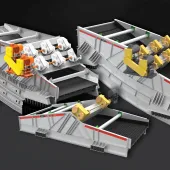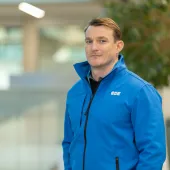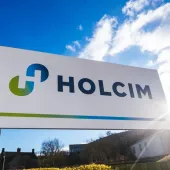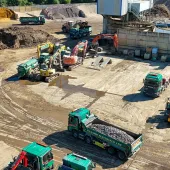The Benefits of a CDE Dry Screening Plant at a German Waste-Recycling Project

First published in the August 2014 issue of Quarry Management as The Need to Feed
Gareth Kenwell of CDE Global outlines the key benefits of the company’s R2500 screening unit currently feeding a new EU Eco-Innovation Funded CD&E waste-recycling project operating in Germany
CDE have recently expanded their product range with the introduction of the new R2500 dry screening plant – a static primary unit with a specialized feeding system capable of processing more than 500 tonnes/h in quarrying, recycling and mining operations.
The latest machine represents an expansion to CDE’s portfolio of products and broadens the range of services that the company provides. It was designed at the new CDE Innovation Centre in Northern Ireland and has been developed to seamlessly integrate into an existing or new system, delivering increased efficiency on site.
Providing solutions to the world’s leading construction companies ensures that CDE are constantly researching and developing new products and a particular focus during 2013 and early 2014 was the development of equipment solutions capable of processing more than 500 tonnes/h.
Currently, the R2500 is successfully processing materials across a range of challenging applications, from C&D waste to scalpings from a quarry face. The plant has been designed primarily as a screening unit for oversize protection at the beginning of a process, but several features on the R2500 are said to make this a superior feed system for any project.
Feed options
There are two options for feeding the R2500. One of the standard features of the base model is a belt feeder that ensures the most efficient transfer of material to the ProGrade screen. The 1,400mm belt width ensures a discharge opening close to the width of the screen, allowing the smooth flow of materials; this being a key focus of CDE’s ‘transfer point technology’.
The entire CDE product range is designed with transfer point technology in mind to ensure maximum water and material retention within a system. An optional feature is the apron feeder which is fitted with foldable hopper sides. It ensures there is no belt slippage and is also tear- and impact-resistant. This ensures both reduced wear and reduced maintenance, with no time spent replacing pierced or ripped belting.
The inclined apron feeder also increases efficiency as it captures the maximum amount of feed materials with minimum spillage. Dual-drive gearboxes ensure the highest torque (30,000Nm) is transmitted into the belt or apron feeder in order to meet the most demanding applications on any site.
Feed capacity
The hopper has a 20-tonne level fill capacity if hopper extensions are used. This 12.5m3 volume allows high tonnagse per hour, making the R2500 unit suitable for large-scale projects in excess of 500 tonnes/h.
Enda Ivanoff, sales director, said CDE saw an ideal opportunity to increase the processing capability of their solutions with the R2500 for customers who required higher outputs.
He commented: ‘We recognized an opportunity to better service our high- tonnage markets in the most efficient way and to provide our customers with a complete CDE solution across the four sectors in which we operate: construction and recycling; mining, environmental and industrial sands.’
The R2500 can be introduced to ‰ quarrying, recycling and mining operations where a range of difficult materials are processed, including crushed rock, topsoil, scalpings, iron ore and construction and demolition waste.
Feed method
The R2500 screen can be fed from the rear or from either side of the machine. This eliminates the requirement for spillage plates as material spillage is reduced, thereby ensuring a safer, cleaner and more productive site. The hopper can be fed by a wheel loader which can result in substantial savings for plant owners.
Unlike a traditional live head and hopper arrangement which can require an excavator to load, a shovel to push material towards the plant and a second shovel to load lorries or stockpile material, the R2500 can be loaded by wheel loader, eliminating the need for the excavator, which allows plant operators to utilize resources elsewhere on site.
The option of feeding from three sides of the machine helps deliver a constant, even flow of material into the R2500. One R2500 screening unit is currently operational in Stuttgart, Germany, where it is processing CD&E waste and operators are benefitting from charge filling the hopper bin with 24 tonnes of material each morning, thereby delivering a constant even flow of material to the next stage of processing.
The R2500 unit features electric start-up. Around 200% of available torque is achieved for 2s, followed by 150% for up to 60s. This allows feeder starting with the hopper bin completely charged.
Levelling blades can also be added to the machine which helps to regulate an even flow from the feeder. This charge filling allows the operators to carry out other duties while the plant operates efficiently.
Electric power
The R2500 is designed to run on electric power to ensure a cleaner and safer operation. This delivers rapid return on investment, results in less than 80dB operating noise and eliminates environmental pollution from potential oil/diesel spillage.
Electric-powered equipment has been central to the ethos of CDE for more than two decades, illustrating their long- running focus on environmentally friendly systems for customers.
The R2500 can be viewed at next month’s CDE open-day event in Stuttgart, Germany. The event will run for one week commencing 15th September and will highlight a series of product developments aimed at improving the quality of recycled sand and aggregates produced from CD&E waste.
For more information visit: www.cdeglobal.com
- Subscribe to Quarry Management, the monthly journal for the mineral products industry, to read articles before they appear on Agg-Net








